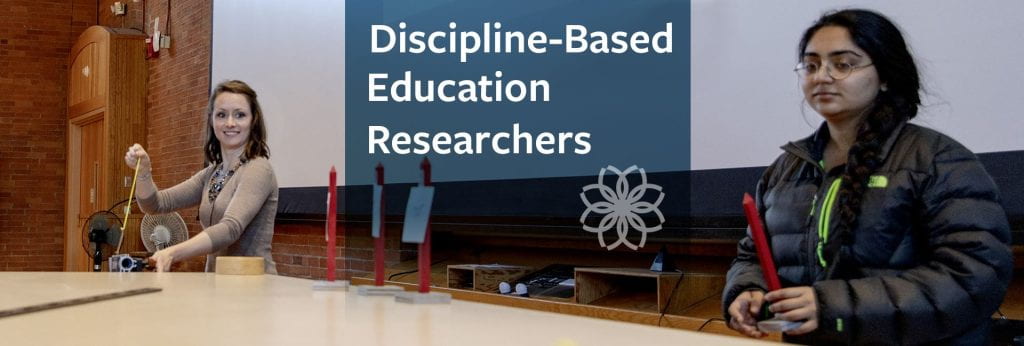Nobel prize-winning physicist and educator Carl Wieman brings people together. Specifically, he brings DBERs together. But this requires an explanation.
In our first blog of this two-part series, we left you with the idea that active learning is an evidence-based practice, and that there are academics who specialize in the marriage of educational research with scientific research.
Those academics are known affectionately as DBERs. And Wieman’s visit to Cornell last September was the first time all of Cornell’s DBERs gathered together to discuss their work.
Discipline-Based Education Researchers
In case you’re unfamiliar with the term: DBERs are discipline-based education researchers; faculty who center discipline-based education at the heart of their research and pedagogy. Specifically, discipline-based education research is the evidence-based practice that places an importance on teaching and learning, to help students develop the critical skills and understanding they will need to be successful in their respective fields.
This approach to education is a growing trend, both nationally and here at Cornell. Since 2017, efforts to support DBERs at Cornell have expanded in tandem with the Active Learning Initiative, whose roots were based in part on the initiatives Wieman created at the University of Colorado and the University of British Columbia.
That effort has taken on a life of its own. Back in 2017, Cornell had one DBER faculty member, physicist and educator Natasha Holmes. But this September, nearly 25 faculty, graduate students and postdocs gathered, to meet with a lauded fellow educator and each other, to discuss what the future might be.
“It has been so energizing to see this community of DBER faculty, postdocs and graduate students grow over the last six years,” said Carolyn Aslan, Senior Associate Director at CTI. “I was struck that (the DBERs were) becoming a larger and larger group, because when I first started working here, there was (just) Natasha.”
Building the DBER network
The effort to build DBER at Cornell first began when the Department of Physics hired Holmes for a tenure track position with a difference: Holmes’ expertise is in physics education research – in other words, studying how the learning of physics is best accomplished. Holmes had collaborated with Wieman at Stanford University, where she worked as a postdoc in physics education research.

Holmes’ hiring was followed by that of Michelle Smith, Ann S. Bowers Professor of Biology, in the Department of Ecology & Evolutionary Biology. Smith had worked with Wieman in Colorado as a postdoctoral fellow in education research.
Now, as the Senior Associate Dean of Undergraduate Education in the College of Arts & Sciences, Smith’s research focuses on understanding what classroom techniques help students learn, how to effectively assess learning, and how to support faculty who implement change. In January 2023, Holmes and Smith were both featured in an article in Nature for their work as education researchers.
Prior to that, in 2019, they were awarded three-year National Science Foundation grants for their DBERs work, including a collaborative grant that combined their research programs. One grant studied equity in undergraduate physics labs, while the other developed an instrument to measure and assess undergraduates’ critical thinking in the context of ecology data, building on a previous project led by Holmes. In 2021, Smith was also awarded a two million dollar NSF grant to fund assessment of biology education.
The College of Engineering has also embraced the DBER initiative, and the growing cohort of DBERs also includes Allison Godwin, Associate Professor of Chemical and Biomolecular Engineering, and Alexandra Werth, Assistant Professor of Biomedical Engineering.
Then there’s Rene Kizilcec, Assistant Professor of Information Science and Director of the Future of Learning Lab. Kizilcec’s research is adjacent to discipline based education, in that it looks at how the ways people learn are changing, and the impact that technology, and the use of technology, can have in both formal and informal learning environments.
While Kizilcec doesn’t consider himself exactly a DBER scholar, his research on the intersections of education and technology, and his focus on education research, is very much in the spirit of his DBER colleagues’ work.
The DBER network has continued to expand informally, and now includes professors, graduate students and postdocs in Economics, Math and other Biology departments, as well as other departments at Cornell. It’s the result of colleagues with shared priorities befriending each other, sharing ideas, and beginning to build community around research-based educational approaches.
CTI’s role is to work with the education researchers individually but also try to foster a sense of community where they can talk to each other and work with each other, learning from each other in the process.
A Meeting of the Minds
Cornell’s DBER cohort met with Wieman during his visit to Cornell as an A.D. White Professor-at-Large. Together, they highlighted areas for future education research, including essential questions of how to address differences in incoming preparation of students so that everyone can be successful, and how to best design homework and assessment methods for optimal feedback and learning.
Wieman spoke to the group about how he has seen the growth of DBER over time, starting mainly with Physics education, but now expanding to many disciplines with a much broader range of research topics. He also has observed an increase in rigorous research grounded in theory.
The DBER growth Wieman described sounded familiar to those who had seen DBER growth at Cornell. As a field, DBER is starting to develop its own theory, and develop as a discipline. That growth has not slowed: rather, the discussion that day ended with talk of the future of DBER at Cornell.
The sense of possibility in the room was palpable. How do the DBERs continue to stay connected? Where could more opportunities for collaboration be created, both within Cornell and also with other universities and community colleges locally and nationally?
Wieman’s visit may have been the reason for the DBER group to gather, but their network, constellated in departments across Cornell, will move forward on the strength of their connections.
